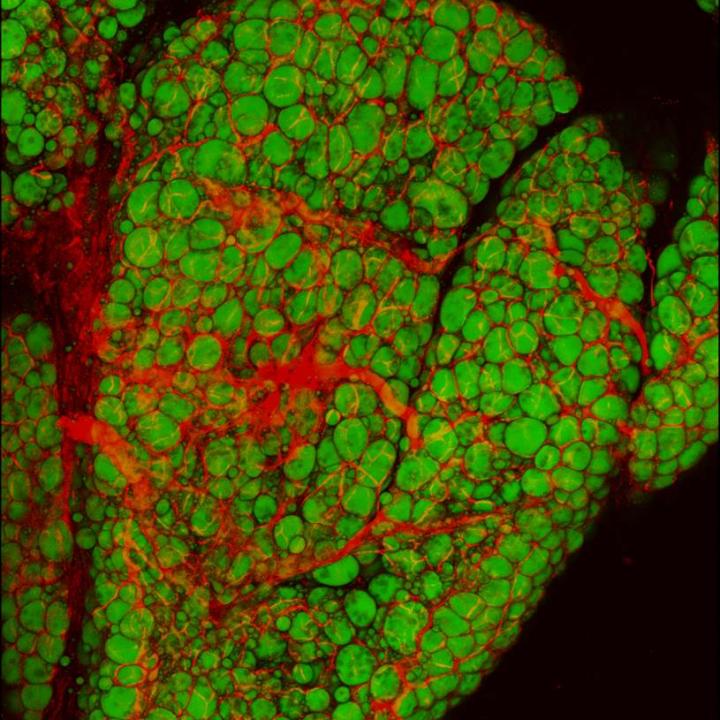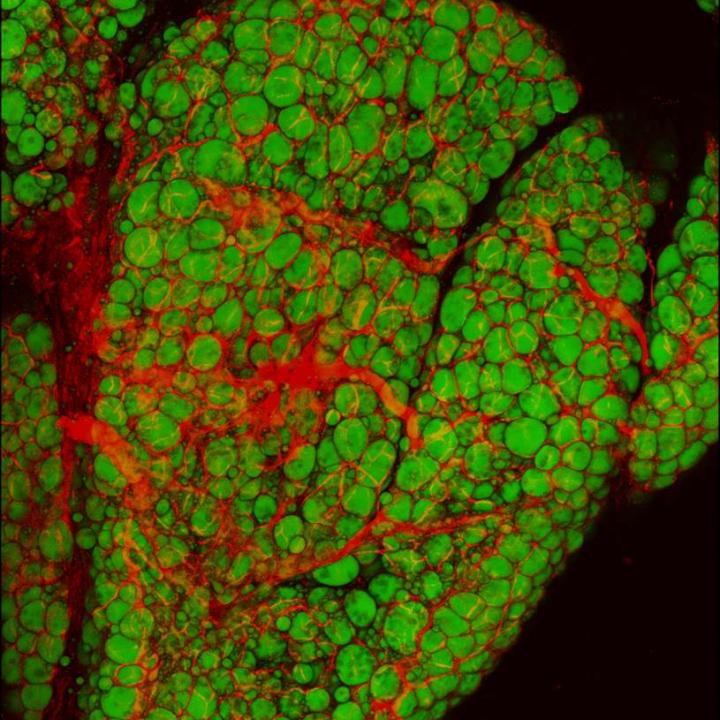
Credit: The laboratory of Zoltan Arany, MD, PhD, Perelman School of Medicine, University of Pennsylvania
PHILADELPHIA– A signaling pathway in fat cells may one day provide the key to better treatments for obesity, according to new research by scientists in the Perelman School of Medicine at the University of Pennsylvania. They reported their findings online ahead of print in Genes & Development.
Ordinary fat cells, also called white adipocytes, stuff themselves with fat molecules to store up energy, and their overloading leads to obesity and related conditions, including diabetes. Brown adipocytes, which are prevalent in children as "baby fat," but much less so in adults, do virtually the opposite: they burn energy rapidly to generate heat, and thereby protect the body from cold as well as obesity and diabetes. The signaling pathway discovered by the Penn scientists activates a "browning program" in white adipocytes, making them more like energy-burning brown adipocytes.
"It's conceivable that one would be able to target this pathway with a drug, to push white fat to become brown fat and thereby treat obesity," said the study's senior author Zoltan P. Arany, MD, PhD, an associate professor of Cardiovascular Medicine. About 36 percent of American adults are considered obese and nearly 10 percent have type 2 diabetes.
Arany and colleagues found that the browning program in white adipocytes is normally suppressed by a protein called FLCN. It performs this function in cooperation with a major cellular signaling hub, a protein complex known as mTOR. The FLCN-mTOR interaction keeps the browning program switched off by preventing a protein called TFE3 from entering the cell nucleus.
The scientists showed that deleting the FLCN gene in the white adipocytes of mice allows TFE3 to migrate into the nucleus, where it binds to DNA and activates a key regulator of cellular metabolism called PGC-1β. It then turns on the set of genes for the browning program.
In the mice in which FLCN was deleted, white adipocytes became visibly browner as they produced more mitochondria–tiny, oxygen reactors that supply chemical energy within cells and convert energy to heat in brown adipocytes. In several other ways too, including their altered cellular structures, mitochondria's higher capacity for consuming oxygen, and their distinctive pattern of gene expression, the cells became more like brown adipocytes.
Arany and his team showed that they could reproduce this browning effect merely by forcing the overexpression of PGC-1β in the white adipocytes of mice. "In principle, a drug that boosts the activity of PGC-1β or some of its target genes might serve as a therapeutic activator of the browning program to curb obesity and treat or prevent diabetes," Arany said.
Aside from its potential medical relevance, the discovery is an important advance in understanding cell biology. "Cellular metabolism is regulated by major signaling pathways and with this study we're linking two of these major pathways, the mTOR and the PGC-1 pathways," Arany said. "The connection between them hasn't been well understood, but here we're clarifying it significantly."
Arany and his team plan further studies of the pathway and its relation to other mTOR signaling pathways.
###
Co-authors of the study include first author Shogo Wada, and Michael Neinast, Cholsoon Jang, Apoorva Babu, Jian Li, Atsushi Hoshino, Michael Morley, Joseph A. Baur, and Patrick Seale, all of Penn; Yasir H. Ibrahim, Gina Lee, and John Blenis of the Weill Cornell School of Medicine; José A. Martina and Rosa Puertollano of the National Heart, Lung and Blood Institute; Glenn C. Rowe of the University of Alabama; and James Rhee of Massachusetts General Hospital.
The study was supported by grants from the National Institutes of Health (T32GM007592, GM51405, HL121266, DK098656, AG043483, DK107667, HL094499).
Penn Medicine is one of the world's leading academic medical centers, dedicated to the related missions of medical education, biomedical research, and excellence in patient care. Penn Medicine consists of the Raymond and Ruth Perelman School of Medicine at the University of Pennsylvania(founded in 1765 as the nation's first medical school) and the University of Pennsylvania Health System, which together form a $5.3 billion enterprise.
The Perelman School of Medicine has been ranked among the top five medical schools in the United States for the past 18 years, according to U.S. News & World Report's survey of research-oriented medical schools. The School is consistently among the nation's top recipients of funding from the National Institutes of Health, with $373 million awarded in the 2015 fiscal year.
The University of Pennsylvania Health System's patient care facilities include: The Hospital of the University of Pennsylvania and Penn Presbyterian Medical Center — which are recognized as one of the nation's top "Honor Roll" hospitals by U.S. News & World Report — Chester County Hospital; Lancaster General Health; Penn Wissahickon Hospice; and Pennsylvania Hospital — the nation's first hospital, founded in 1751. Additional affiliated inpatient care facilities and services throughout the Philadelphia region include Chestnut Hill Hospital and Good Shepherd Penn Partners, a partnership between Good Shepherd Rehabilitation Network and Penn Medicine.
Penn Medicine is committed to improving lives and health through a variety of community-based programs and activities. In fiscal year 2015, Penn Medicine provided $253.3 million to benefit our community.
Media Contact
Karen Kreeger
[email protected]
215-349-5658
@PennMedNews
http://www.uphs.upenn.edu/news/
############
Story Source: Materials provided by Scienmag




